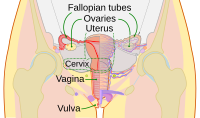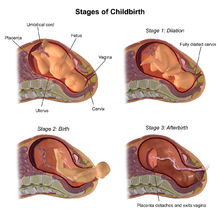Vagina
| Vagina | |
|---|---|
 Diagram of the female human reproductive tract and ovaries | |
 Vulvawithpubic hairremoved andlabiaspread to show the opening of the vagina:
| |
| Details | |
| Precursor | urogenital sinusandparamesonephric ducts |
| Artery | superior part touterine artery,middle and inferior parts tovaginal artery |
| Vein | uterovaginal venous plexus,vaginal vein |
| Nerve |
|
| Lymph | upper part tointernal iliac lymph nodes,lower part tosuperficial inguinal lymph nodes |
| Identifiers | |
| Latin | Vagina |
| MeSH | D014621 |
| TA | A09.1.04.001 |
| FMA | 19949 |
| Anatomical terminology | |
Thevaginais a part of thefemalebody. It is between theperineumand theurethra.The vaginal opening is much larger than theurethralopening. It is a tube leading from the uterus to the outside of the body. Menstrual fluid (red, blood-filled liquid lost duringmenstruation) leaves the body through the vagina. Duringsexual intercourse,thepenisis put into the vagina. Duringbirth,the vagina opens to let thebabycome out from theuterus.The vagina is reddish-pink in color, though colors may vary.
Development
[change|change source]Between the ages of 9-15 years, the vagina anduterusget bigger. The uterus is the organ in which a baby grows. The external opening of the vagina leading to thevulva,between the legs. A clear or whitish fluid may start to flow out of the vagina to keep it clean.[1]
Location
[change|change source]The opening to the vagina is located behind the urethral opening and in front of the perineum. The vagina is the tube leading from theuterusto the outside of the body. The opening is between the legs, inside thelabium,behind the opening to theurethra,and in front of theanus.
Anatomy
[change|change source]The vagina is anelastic,musculartube.It starts at thecervixand ends at thevulva.[2]It is about 6 to 7.5 centimetres (2.4 to 3.0 in) wide, and 9 centimetres (3.5 in) long.[3]Duringsexual intercourseand childbirth, the vagina gets wider and bigger.[4]It has to be lubricated to stay clean and allow sexual intercourse and childbirth. It is lubricated partially by theBartholin's glands.This lubrication also allowsspermeasier access tofertilizeanovum.
The vaginal biome
[change|change source]
Like many tissues, the vagina has a naturalbiome,afloraandfaunaofmicroscopicorganisms. The vagina is an interface between the host and the environment. Its surface is covered by a protectiveepitheliumwherebacteriaand othermicroorganismsgrow. The ectocervix (that's the vaginal part of thecervix) is not sterile.[5]
Functions
[change|change source]Release
[change|change source]
The vagina releasesbloodandtissueduring menstruation.Tamponsor other products can be used to absorb some of the blood.[6]
Sexual activity
[change|change source]


When a woman isaroused,she has pleasurable feelings in her genital region. The vagina gets up to 8.5 centimetres (3.3 in) wide. It can get bigger with more stimulation.[7]During sexual intercourse, the man'spenisis placed in the woman's vagina. The vagina is warm and soft, and it places pressure on the man's penis. That can feel good for both partners and usually makes the man have anorgasmafter repeated thrusts. For orgasm in women, the vagina has significantly fewernerveendings than theclitoris,and therefore rubbing or applying other consistent pressure against the clitoris is usually needed to help the woman have an orgasm.[8][9]During the man's orgasm, he ejaculatessemenfrom his penis into the vagina. The semen containssperm.The sperm can move from the vagina into the uterus to fertilize aneggand make a woman pregnant.
TheG-spotmay be a highly sensitive area near the entrance inside of the human vagina.[10]If stimulated, it leads to a strongorgasmorfemale ejaculationin some women.[11][12][13]Somedoctorsand researchers who specialize in theanatomyof women believe that the G-spot does not exist, and that if it does exist, it is an extension of the clitoris.[14][15][16][17]
Childbirth
[change|change source]

During birth, the vagina acts as a pathway for the baby to leave the mother's body. The vagina is very elastic and stretches to many times its normaldiameterduring birth.
Pregnancy
[change|change source]Sperm needs to be deposited at the top of the vagina near thecervixand fertilize the ovum (egg) if pregnancy is to occur. In a normal childbirth,babiescome out through the vagina.
Related pages
[change|change source]References
[change|change source]- ↑Marshall,Human Growth,p. 187.
- ↑http:// womenshealth.gov/glossary/#vaginaWomenshealth.gov
- ↑Gray's Anatomy
- ↑"The sexual response cycle".EngenderHealth.Archived fromthe originalon 2007-10-30.Retrieved2007-10-13.
- ↑'sterile' here means having no biome on the surface.
- ↑"All about Menstruation".Retrieved2010-05-14.
- ↑"Does size matter".TheSite.org.Archived fromthe originalon 2007-02-21.Retrieved2006-08-12.
- ↑Psychology Applied to Modern Life: Adjustment in the 21st Century.Cengage Learning. 2011. p. 386.ISBN978-1-111-18663-0.RetrievedNovember 14,2012.
{{cite book}}:Unknown parameter|authors=ignored (help) - ↑Sex and Society, Volume 2.Marshall Cavendish Corporation. 2009. pp. 960 pages.ISBN978-0761479079.RetrievedNovember 14,2012.
{{cite book}}:Unknown parameter|authors=ignored (help) - ↑Darling, CA; Davidson, JK; Conway-Welch, C. (1990)."Female ejaculation: perceived origins, the Grafenberg spot/area, and sexual responsiveness".Arch Sex Behav.19(1): 29–47.doi:10.1007/BF01541824.ISSN0004-0002.PMID2327894.S2CID25428390.
{{cite journal}}:CS1 maint: multiple names: authors list (link) - ↑Crooks, R; Baur, K (1999).Our Sexuality.California: Brooks/Cole.ISBN9780534354671.
- ↑Jannini E, Simonelli C, Lenzi A (2002). "Sexological approach to ejaculatory dysfunction".Int J Androl.25(6): 317–23.doi:10.1046/j.1365-2605.2002.00371.x.PMID12406363.S2CID85033696.
{{cite journal}}:CS1 maint: multiple names: authors list (link) - ↑Jannini E, Simonelli C, Lenzi A (2002). "Disorders of ejaculation".J Endocrinol Invest.25(11): 1006–19.doi:10.1007/BF03344077.PMID12553564.S2CID9852872.
{{cite journal}}:CS1 maint: multiple names: authors list (link) - ↑Hines, T (August 2001)."The G-Spot: A modern gynecologic myth".Am J Obstet Gynecol.185(2): 359–62.doi:10.1067/mob.2001.115995.PMID11518892.
- ↑O'Connell HE, Sanjeevan KV, Hutson JM (October 2005). "Anatomy of the clitoris".The Journal of Urology.174(4 Pt 1): 1189–95.doi:10.1097/01.ju.0000173639.38898.cd.PMID16145367.S2CID26109805.
{{cite journal}}:CS1 maint: multiple names: authors list (link)"Time for rethink on the clitoris".BBC News.11 June 2006. - ↑"Is the Female G-Spot Truly a Distinct Anatomic Entity?".The Journal of Sexual Medicine.2011(3): 719–726. January 2012.doi:10.1111/j.1743-6109.2011.02623.x.PMID22240236.
{{cite journal}}:Unknown parameter|authors=ignored (help)"G-Spot Does Not Exist, 'Without A Doubt,' Say Researchers".Huffington Post.January 19, 2012. - ↑Alexander, Brian (January 18, 2012)."Does the G-spot really exist? Scientists can't find it".MSNBC.Archived fromthe originalon March 3, 2012.RetrievedMarch 2,2012.
Other websites
[change|change source]- Pink PartsArchived2008-10-22 at theWayback Machine- More information on female sexual anatomy.

